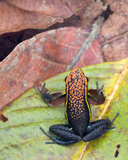|
Ameerega pepperi Brown & Twomey, 2009
| family: Dendrobatidae subfamily: Colostethinae genus: Ameerega |
| Species Description: Brown JL, Twomey E 2009 Complicated histories: three new species of poison frogs of the genus Ameerega (Anura: Dendrobatidae) from north-central Peru. Zootaxa 2049:1-38. | |
 © 2010 Brad Wilson (1 of 9) |
|
|
|
Description The most notable characteristic to distinguish A. pepperi from similar species is the red, orange, or yellow coloration on the dorsal side of this species. Ameerega pepperi has a dorsolateral stripe whereas A. parvula and A. bilinguis lack this distinct patterning. Both A. cainarachi and A. macero are smaller in size than A. pepperi. The largest variation between this species and closely related species is the mate calling patterns heard from these species. Whereas A. pepperi has a series of burst notes that are modulated by frequency, A. cainarachi has a regular chain of notes that can be heard, A. macero has a series of peeps that are very intense, A. bassleri has a chorus of whistles repeated for several minutes, and A. yoshina produces more notes per second than A. pepperi (Brown and Twomey 2009). Ameerega pepperi are characterized by their black dorsal coloration with red, orange or yellow patterning depending on the location of the individual. This patterning is more vivid and clustered near the head and becomes less dense near the rear. They have two yellow dorsolateral stripes that originate near the eye and end near the groin, where they are slightly wider than by the eye. They also have a yellow labial stripe that begins near the nares. The limbs are either black or a dark green color with small patches of tan or olive. The hind legs also contain femoral spots that are yellow in color. In contrast, the forearms contain yellow coloration that stretches up toward the mouth. The ventral side has a dark blue coloration with many black streaks and splotches. The irises are black in color as well. When preserved in alcohol, the species remains very similar in color, although the red and yellow colorations on the dorsal side often change to a black color and an silver-white color, respectively (Brown and Twomey 2009). The largest variation between individuals is dorsal coloration, which is tied to geographic location. The populations in the southern part of their range have more red on their dorsal side and the populations in the north have more orange or yellow on their dorsal side near the head. This variation creates a gradient of color change throughout their range (Brown and Twomey 2009). Distribution and Habitat Country distribution from AmphibiaWeb's database: Peru
Life History, Abundance, Activity, and Special Behaviors The mating call of A. pepperi is a series of whistle-like sounds or “retarded trill” that gets produced at a rate of 0.9 - 1.3 notes per second. Each call produces a dominant frequency of 2970 Hz and note duration is for 130 - 220 ms with a lag of 560 - 1030 ms in between. Calling activity for this species happens most frequently around dusk when the males have reached a preferable position on an elevated rock or log (Brown and Twomey 2009). Once a call has been made, courtship and mating takes place among the leaf litter on the ground. The female produces clutches of 22 - 44 eggs at a time, which are guarded by the males until they hatch around eighteen days later. Tadpoles develop in streams that have a clay-like sediment that the tadpoles can easily bury themselves into, especially when the weather becomes hotter. These tadpoles take approximately five to six weeks to reach full development (Brown and Twomey 2009). Trends and Threats Possible reasons for amphibian decline General habitat alteration and loss Comments Ameerega pepperi belongs to the A. bassleri clade. It is most closely related to A. bassleri and is more distantly related to both A. ignipedis and A. yoshina (Brown and Twomey 2009). The species was named after Canadian conservationist Mark Pepper who is responsible for a greater understanding of poison frog biogeography and taxonomy (Brown and Twomey 2009). It is suggested that the cause of speciation between A. pepperi and similar larger, more colorful species like A. bassleri and A. yoshina is differences in behavior and vocal mating calls. However, the only areas that A. pepperi and its sister species A. bassleri have been found together occurs in Juanjui, which suggests that geographic separation may also be an important factor in the speciation of these frogs (Brown and Twomey 2009).
References
Brown, J. L., and Twomey, E. (2009). ''Complicated histories: three new species of poison frogs of the genus Ameerega (Anura: Dendrobatidae) from north-central.'' Zootaxa, 2049, 1-38. Originally submitted by: Katie Hindorff (first posted 2016-07-16) Edited by: Ann T. Chang (2016-07-28) Species Account Citation: AmphibiaWeb 2016 Ameerega pepperi <https://amphibiaweb.org/species/7276> University of California, Berkeley, CA, USA. Accessed Jun 6, 2025.
Feedback or comments about this page.
Citation: AmphibiaWeb. 2025. <https://amphibiaweb.org> University of California, Berkeley, CA, USA. Accessed 6 Jun 2025. AmphibiaWeb's policy on data use. |


 Map of Life
Map of Life